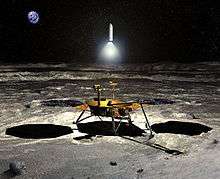MoonRise
| Mission type | Lunar sample return |
|---|---|
| Operator | NASA / Jet Propulsion Laboratory |
| Start of mission | |
| Launch date | Proposed: October 2016 |
| Rocket | Atlas V 531 |
| Launch site | Cape Canaveral SLC-41 |
| Contractor | United Launch Alliance (for launch) |
MoonRise was a proposed mission to the Moon as part of NASA's New Frontiers program. It would have focused on the giant South Pole–Aitken basin (SPA basin) on the far side of the Moon between the Moon's South Pole and Aitken Crater, 16° south of the Moon's equator. This basin measures nearly 2,500 kilometres (1,600 mi) in diameter and 12 kilometres (7.5 mi) in depth. This region is the oldest, deepest, observable impact basin on the Moon and provides a window into the deep crust of the Moon and its history as a result. The basin is also among the largest recognized impact structures in the Solar System.[1] The mission would have been NASA's first unmanned sample-return mission from another planetary body.[2]
MoonRise was not selected for the third New Frontiers program launch, losing out to the OSIRIS-REx asteroid sample return mission.[3]
Science objectives

.png)
MoonRise had the following objectives:[1]
- Determine the impact chronology of the SPA basin
- Investigate processes associated with the formation of large impact basins
- Investigate the materials excavated from the deeper crust, and possibly the mantle, of the Moon within the SPA basin
- Determine rock types, distribution of thorium, and implications for the Moon's thermal evolution
- Sample and analyze basaltic rock and volcanic glass, which record the composition and chemical evolution of the Moon's far-side mantle beneath the SPA basin
Future prospects
MoonRise received Phase A funding out of the New Frontiers program.[4] The study was on of three concepts to get US$3.3 million funding in 2010 to further developed the mission for the final selection, which was a US$650 million mission to launch in the late 2010s.[2] The three semi-finalists were MoonRise, the OSIRIS-REx sample return mission, and the Venus In Situ Explorer mission.[2]
Although MoonRise was passed over in favor of OSIRIS-REx in the 2011 selection, a South Pole–Aitken basin sample return mission remains part of the 2013-2022 Planetary Science Decadal Survey's recommendation for potential New Frontiers missions,[5] and NASA's Planetary Science Division has expressed support for the Decadal Survey's recommendations.[6]
See also
- Origin of the Moon
- Stardust (spacecraft), a 1999 cometary coma sample return mission
References
- 1 2 "MoonRise" (PDF). NASA Facts. NASA. June 2010. Archived from the original (PDF) on 16 May 2011.
- 1 2 3 "WUSTL-led Moon mission is finalist for NASA’s next big space venture". Washington University in St. Louis. 31 December 2009.
- ↑ Clark, Stephen (25 May 2011). "NASA picks robotic asteroid voyager for liftoff in 2016". Spaceflight Now. Retrieved 19 November 2016.
- ↑ Alkalai, L.; Jolliff, B.; Papanastassiou, D. (2010). An Overview of the MoonRise Lunar Sample Return Mission from the South Pole-Aitken Basin (PDF). 7th International Planetary Probe Workshop. 14-18 June 2010. Barcelona, Spain.
- ↑ Vision and Voyages for Planetary Science in the Decade 2013-2022 (PDF). The National Academies Press. 2011. pp. 15–16. ISBN 978-0-309-22464-2.
- ↑ Weiler, Edward J. (29 July 2011). "Planetary Science Division Response to the Planetary Science Decadal Survey" (PDF) (Letter). Letter to Charles F. Kennel.
External links

